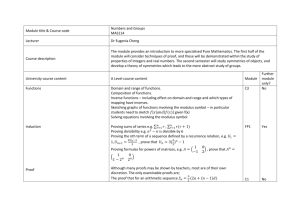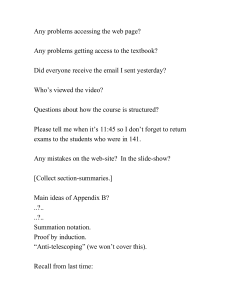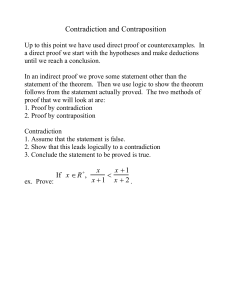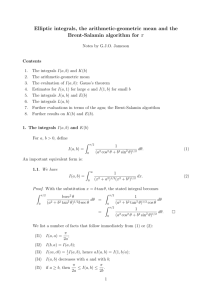Some Things Every Math Major Should Know 1. Derive the
advertisement
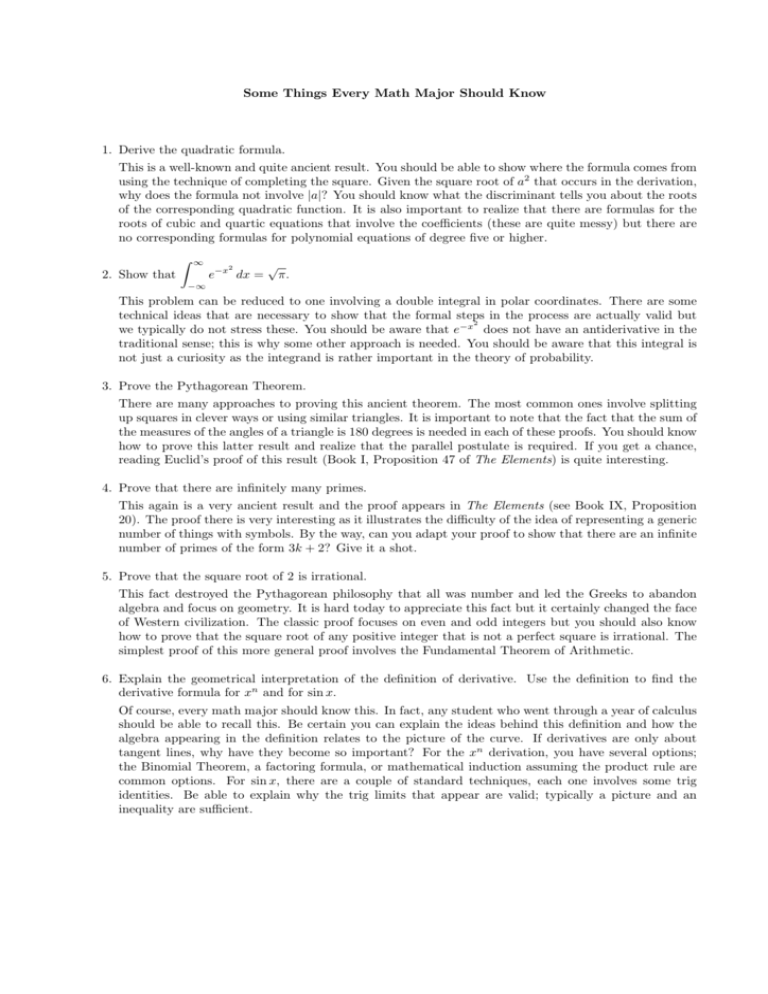
Some Things Every Math Major Should Know 1. Derive the quadratic formula. This is a well-known and quite ancient result. You should be able to show where the formula comes from using the technique of completing the square. Given the square root of a2 that occurs in the derivation, why does the formula not involve |a|? You should know what the discriminant tells you about the roots of the corresponding quadratic function. It is also important to realize that there are formulas for the roots of cubic and quartic equations that involve the coefficients (these are quite messy) but there are no corresponding formulas for polynomial equations of degree five or higher. Z ∞ 2. Show that 2 e−x dx = √ π. −∞ This problem can be reduced to one involving a double integral in polar coordinates. There are some technical ideas that are necessary to show that the formal steps in the process are actually valid but 2 we typically do not stress these. You should be aware that e−x does not have an antiderivative in the traditional sense; this is why some other approach is needed. You should be aware that this integral is not just a curiosity as the integrand is rather important in the theory of probability. 3. Prove the Pythagorean Theorem. There are many approaches to proving this ancient theorem. The most common ones involve splitting up squares in clever ways or using similar triangles. It is important to note that the fact that the sum of the measures of the angles of a triangle is 180 degrees is needed in each of these proofs. You should know how to prove this latter result and realize that the parallel postulate is required. If you get a chance, reading Euclid’s proof of this result (Book I, Proposition 47 of The Elements) is quite interesting. 4. Prove that there are infinitely many primes. This again is a very ancient result and the proof appears in The Elements (see Book IX, Proposition 20). The proof there is very interesting as it illustrates the difficulty of the idea of representing a generic number of things with symbols. By the way, can you adapt your proof to show that there are an infinite number of primes of the form 3k + 2? Give it a shot. 5. Prove that the square root of 2 is irrational. This fact destroyed the Pythagorean philosophy that all was number and led the Greeks to abandon algebra and focus on geometry. It is hard today to appreciate this fact but it certainly changed the face of Western civilization. The classic proof focuses on even and odd integers but you should also know how to prove that the square root of any positive integer that is not a perfect square is irrational. The simplest proof of this more general proof involves the Fundamental Theorem of Arithmetic. 6. Explain the geometrical interpretation of the definition of derivative. Use the definition to find the derivative formula for xn and for sin x. Of course, every math major should know this. In fact, any student who went through a year of calculus should be able to recall this. Be certain you can explain the ideas behind this definition and how the algebra appearing in the definition relates to the picture of the curve. If derivatives are only about tangent lines, why have they become so important? For the xn derivation, you have several options; the Binomial Theorem, a factoring formula, or mathematical induction assuming the product rule are common options. For sin x, there are a couple of standard techniques, each one involves some trig identities. Be able to explain why the trig limits that appear are valid; typically a picture and an inequality are sufficient. 7. Derive Newton’s method. Drawing a good picture for this situation (after explaining what the method is designed to do) and running through two or three iterations should reveal to the viewer how quickly Newton’s method works in many cases. You should then carefully show the algebraic steps behind the formula. Be prepared to give some graphical examples to illustrate that Newton’s method can run into problems in some cases. 8. Explain the geometrical interpretation of the definition of the definite integral (the simple limit definition for continuous functions using partitions of equal width and right endpoints as tags). Be able to use it to integrate x2 over the interval [0, b], where b is a positive constant. As with the derivative definition, you need to link the symbols in the integral definition with the corresponding aspects of the associated figure. Do all integrals represent area? Why has integration become useful for applications other than area? The typical integral computation using the definition is much more difficult that the typical derivative computation from the definition. What key result made evaluating many integrals much easier? 9. Explain how to solve a general first order linear differential equation. You need to be able to use symbols to explain why an integrating factor might be helpful to solve these types of equations and show how one determines what the integrating factor should be in the general case. Be able to apply the theory to a special case, that is, actually solve a problem (of our choosing) given to you of this type. 10. Discuss the formula for the sum of a geometric series. You should certainly know the formula for the sum and be able to use it to find the sum of a geometric series. You should be able to use partial sums to explain why the series converges in some cases (and gives the resulting formula) and diverges in others. In general, you should know a little about infinite series and their properties. For instance, the divergence test is a rather simple but important result. 11. Prove Euler’s formula. This formula is quite amazing as it links exponential functions and trigonometric functions, something you would never expect given the nature of these functions when they are first introduced. You can derive the connection using power series or the theory of differential equations. Make certain you are aware of the “nerdy” formula eiπ +1 = 0 and how it is truly astounding that five special numbers appear in a simple formula. By the way, you should be able to use Euler’s formula to figure out what ii is? 12. Derive the formula for the distance from a point to a plane. You can do this in a brute force way; find an equation for the perpendicular line, determine where the line meets the plane, then use the distance formula to find the distance. You can also use vectors and the projection of a vector onto the normal vector of the plane. It is a good idea to be familiar with both approaches. 13. Be able to do a proof by induction. This should be self-explanatory. We typically ask you to do one that is not too complicated but we make certain you truly understand the ideas behind this technique of proof. 14. Prove that R is uncountable. There are several ways to proceed here. If you use decimal expansions, you should note that some numbers have more than one decimal expansion and this means that some care must be used in the proof. You should also know that a number has terminating or repeating decimal expansion if and only if it is a rational number. For the record, you should know that the set of rational numbers is countably infinite. What does this say about the set of irrational numbers?


